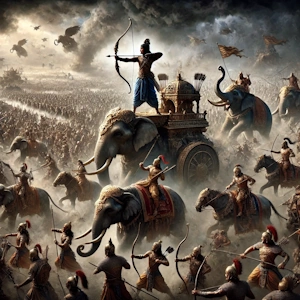Ethical Warfare in Ancient Hindu Tradition

War for protecting motherland, honor and welfare was considered just and righteous in ancient Hindu tradition. Fighting for possessions was seen as noble and inspired others to uphold their values. Hindu warfare emphasized ethics (niti) and valor (shaurya), ensuring that warriors maintained moral principles even in battle. Ancient war treatises (nitishastra) were deeply rooted in religious teachings, reflecting how religion governed all aspects of life. Without ethical constraints, war led to brutality, which lawgivers and Dharmashastras sought to prevent by establishing clear ethical codes. Kings were expected to follow dharma-vijaya, the principle of righteous conquest, ensuring that war was fought within the bounds of morality.
Types of Warfare
Hindu military science categorized war into two primary types: Dharmayuddha (righteous war) and Kutayuddha (unrighteous war). Dharmayuddha followed strict rules, was conducted openly, and had society’s approval. In contrast, Kutayuddha involved deception, secrecy, and unfair tactics. Mantra-yuddha, which used spells and charms, was considered acceptable only for defensive purposes and as a last resort. Early texts did not clearly distinguish between these types, and wars initially had few formal rules. Over time, a structured war code developed to regulate conflicts.
Influence of Asuras and Devas
The Asuras were highly skilled in warfare and often relied on spells and charms (mantra and tantra). Kutayuddha likely originated from their methods. Early Dharmashastras and epics acknowledge the existence of both righteous and unrighteous war. Warriors who broke the war code faced severe punishment. The kshatriyas adhered to strict regulations, and warriors had to master all war methods, including Kutayuddha (to understand the enemy’s strategies). If an enemy used unfair tactics, it was permissible to retaliatesimilarly. Texts like the Dharmashastras, epics, and Arthashastra provide detailed discussions on these principles.
Diplomacy and War
Before engaging in battle, a king sent an ambassador with the message: ‘Fight or submit.’ Over 5000 years ago, India recognized the inviolability of ambassadors, a principle that later appeared in Greek, Roman, and Persian traditions. The Mahabharata warns that killing an envoy would result in damnation. War was always a last resort when diplomacy failed. Strategies such as Sama (conciliation) and Dana (gifts) were used for weaker enemies, while Bheda (division) and Danda (punishment) were reserved for stronger foes. Aggression was rare, and peace was always preferred. If provoked, retaliation was justified. Attacking an enemy’s weak points was an accepted strategy.
Rituals Before Battle
Before war, warriors sought divine support. The king spent a week in prayers, worshipping deities like Hari, Shambhu, Vinayaka, the planets, the Ashvins, rivers, and Narasimha. For example, Tamil kings followed elaborate war rituals. King Senguttuvan consulted an astrologer for an auspicious time, then performed prasthana by taking a sword and umbrella outside the city. He visited a Shiva shrine and wore prasada from a Vishnu temple before hosting a grand feast for his army. War was compared to a Vedic yajna, where warriors who fought bravely were seen as performing a sacred duty. The Mahabharata mentions a shastra (weapon) yajna, equating warriors’ blood to ghee in a yajna. Those slain in battle were believed to attain heaven. The king slept in his chariot with his weapons before battle, and astrologers read omens to predict success. Bad omens required shanti to ensure divine protection.
Rules of Combat
Ancient Hindu warfare followed strict rules:
- A warrior in armor must not fight an unarmored opponent.
- One should fight only one enemy at a time.
- Combat should stop if the opponent is disabled.
- If the enemy wears armor, the opponent must also wear armor.
- A chariot warrior should not attack a cavalry soldier.
- A chariot warrior must fight another chariot warrior.
- A horse warrior should fight another horse warrior.
- Warriors must fight only their equals.
- Poisoned or barbed arrows were forbidden.
- Weak, wounded, or unarmed men must not be attacked.
- A warrior who surrenders must not be killed but could be taken as a prisoner.
- A king must not fight warriors of lower rank.
- Panic-stricken or retreating enemies should not be pursued.
- Mediators bringing peace must not be harmed.
- War should stop at night and resume during the day.
Protection of Civilians and Property
War did not disturb daily life. Enemy lands were not burned, nor were trees cut down. Farmers were never harmed. Trade and commerce remained undisturbed. Prisoners of war were treated kindly, often freed after a period of service. Fair fighting rules prohibited refusing a duel. Chandragupta’s minister followed these principles and set prisoners free after the war. Defeated kings were usually reinstated under the victor’s rule. Conquered people retained their customs and laws.
Care for the Wounded
Wounded enemies were treated with care and released once recovered. Women and physicians attended to the injured. Victors were expected to show sympathy towards the defeated. Kings personally visited wounded soldiers at night to offer comfort. Enemies behaved as allies once the battle ended.
Ancient Hindu warfare was based on ethical and religious principles, ensuring that war remained a duty rather than an act of destruction. The strict war code balanced valor with morality, emphasizing justice, honor, and compassion even in the midst of battle. This unique approach distinguished Hindu military traditions from many others, leaving a legacy of ethical warfare that influenced later civilizations.

English
Bharat Matha
Click on any topic to open
- 44 The Greatness of Hindu Family Life
- 43 Ethical Warfare in Ancient Hindu Tradition
- 42 Agnikula: The Fire Lineage of Rajputs
- 41 Longevity of Our Ancients
- 40 Brahmacharya Stage of Life in Ancient Bharat
- 39 Alwar City and Mahabharata
- 38 Zoroastrianism: An Offshoot of the Vedic Religion
- 37 Origin of the Terms, Hindu and Hindustan
- 36 Vedic and Zoroastrian Religions: A Role Reversal
- 35 Harappa was Hariyupiya: Rigveda Refutes Aryan Migration Theory
- 34 Descendants of Lord Rama and Yudhishthira: Royal Legacies in History
- 33 The Revolutionary Legacy of Abhinav Bharat: A Comprehensive Look
- 32 Geography in Mahabharata
- 31 Seven Ancient Kingdoms to the West of Sindhu
- 30 Guru Ram Singh - A Hero Of Indian Freedom Movement
- 29 Bharata Varsha = Indian Peninsula + Eight Islands. Which Are They?
- 28 The Puranic Geography Of Bharata Varsha
- 27 Many Rishis Consider Indra and Varuna as Equals
- 26 Devasura Battle At Balkh
- 25 Vrishakapi the Asura Chief
- 24 The History of Alcohol
- 23 Founding of the Asura Religion
- 22 Bharata Varsha Gets Divided Into Two Parts
- 21 How Siberia Lost Its Status as Swarga on Earth
- 20 How Did Bharata Varsha Get Its Name?
- 19 We Should Build Temples for Bharat Mata and Worship Her
- 18 There Is Brahmaloka and Vishnuloka on the Surface of Earth Also
- 17 There Is Agniloka, Vayuloka, and Indraloka on the Surface of Earth Also
- 16 What Is the Role of Religion in a Secular Nation?
- 15 Lesser Known Facts About Jhansi Rani - Part 3
- 14 Lesser Known Facts About Jhansi Rani - Part 2
- 13 Lesser Known Facts About Jhansi Rani - Part 1
- 12 The Childhood of Sardar Patel
- 11 What Exactly is Jamboo Dwipa?
- 10 Actions in Bharata Varsha Alone Earn Punya and Papa
- 9 How Pilgrimages Held Bharata Together as a Single Nation
- 8 Rigveda on Seven Punya Nadis of Hindustan
- 7 How Rivers Helped in Keeping India as a Single Unit
- 6 Natural Abundance Shaped India's Thought Process
- 5 Importance of Prayag
- 4 Revisiting Education through the Lens of Sanatana Dharma
- 3 God Is Love, Said Tamil Saint Thirumular
- 2 Why All Avataras Happened in India Only?
- 1 Our Culture Is Strong Because It Is Based On Eternal Truth
7
30
Astrology
Atharva Sheersha
Bhagavad Gita
Bhagavatam
Bharat Matha
Devi
Devi Mahatmyam
Ganapathy
Glory of Venkatesha
Hanuman
Kathopanishad
Mahabharatam
Mantra Shastra
Mystique
Practical Wisdom
Purana Stories
Radhe Radhe
Ramayana
Rare Topics
Rituals
Rudram Explained
Sages and Saints
Shiva
Spiritual books
Sri Suktam
Story of Sri Yantra
Temples
Vedas
Vishnu Sahasranama
Yoga Vasishta